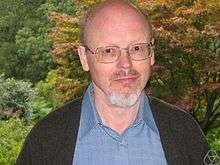Aleksei Parshin
Aleksei Nikolaevich Parshin, sometimes romanized as Alexey Nikolaevich Paršin, (Russian: Алексей Николаевич Паршин; born 7 November 1942 in Sverdlovsk) is a Russian mathematician, specializing in arithmetic geometry.
Aleksei N. Parshin | |
|---|---|
 Aleksei Parshin in Oberwolfach 2005 | |
| Born | 7 November 1942 |
| Nationality | Russian |
| Alma mater | Steklov Institute of Mathematics |
| Known for | |
| Awards |
|
| Scientific career | |
| Fields | Mathematics |
| Institutions | |
| Doctoral advisor | Igor Shafarevich |
Education and career
Parshin graduated in 1964 from the Faculty of Mathematics and Mechanics of Moscow State University and then enrolled as a graduate student at the Steklov Institute of Mathematics, where he received his Kand. Nauk (Ph.D.) in 1968 under Igor Shafarevich.[1] In 1983 he received his Russian doctorate of sciences (Doctor Nauk) from Moscow State University. He is now a professor at the Steklov Institute in Moscow, where he is the head of the Department of Algebra, and he is also a professor at Moscow State University.
Parshin proved in 1968 that the Mordell conjecture is a logical consequence of Shafarevich's finiteness conjecture concerning isomorphism classes of abelian varieties via what is known as Parshin's trick, which gives an embedding of an algebraic curve into the Siegel modular variety.[2][3] In 1983 Gerd Faltings proved Shafarevich's finiteness conjecture (and thereby the Mordell conjecture).[3]
Shafarevich proved his conjecture for the case with genus g = 1. In 1968 Parshin proved a special case (for S = the empty set) of the following theorem: If B is a smooth complex curve and S is a finite subset of B then there exist only finitely many families (up to isomorphism) of smooth curves of fixed genus g ≥ 2 over B \ S.[4] The general case (for non-empty S) of the preceding theorem was proved by Arakelov.[4][5] At the same time, Parshin gave a new proof (without an application of the Shafarevich finiteness condition) of the Mordell conjecture in function fields (already proved by Yuri Manin in 1963 and by Hans Grauert in 1965).[6] Parshin presented his results in his talk Quelques conjectures de finitude en géométrie diophantienneas an invited speaker at the ICM in 1970 in Nice.[7]
Parshin's research deals with generalizations of class field theory in higher dimensions, with integrable systems, and with the history of mathematics. He was an editor for the Russian edition of the collected works of David Hilbert and was a co-editor, with V. I. Arnold, of selected works of Hermann Weyl.
Parshin is a corresponding member of the Russian Academy of Sciences. At the ICM in 2010 he was a Plenary Speaker with his talk titled Representations of higher adelic groups and arithmetic.[8]
Awards and honors
- 1996 – Humboldt Prize
- 2004 – Vinogradov Prize
- 2012 – Chebyshev Gold Medal
- 2013 – Honorary doctorate from University of Paris XIII
Selected publications
- A. N. Parshin: "Путь. Математика и другие миры" (The Way. Mathematics and Other Worlds) Moscow 2002. (Parshin's writings on Russian science and philosophy)
- With Shafarevich, Parshin edited several volumes in the series "Algebraic Geometry and Number Theory" in the Encyclopedia of mathematical sciences published by Springer Verlag.
- with Shafarevich: The arithmetic of algebraic varieties. Proc. Steklov Institute Math., 1986, No. 3.
- with Yuri Zarin: Finiteness problems in algebraic geometry, in Eight papers translated from the Russian. American Mathematical Society Translations Ser. 2, Vol.143, 1989, pp. 35–102, revised version of the original published as an appendix in the Russian edition of Serge Lang Fundamentals of Diophantine Geometry (English version of the appendix Online)
- Parshin Numbers as functions. The development of an idea in the Moscow school of algebraic geometry, in Bolibruch, Osipov, Sinai (eds.) Mathematical Events of the Twentieth Century, Springer 2006, pp. 297–330
- Parshin Mathematik in Moskau – es war eine große Epoche, Mitteilungen DMV, Vol. 18, 2010, pp. 43–48
Sources
- Sergei Vostokov, Yuri Zarhin (eds.): Algebraic number theory and algebraic geometry: Papers dedicated to A. N. Parshin on his 60th Birthday, American Mathematical Society 2002 (with foreword by Shafarevich)
See also
References
- Paršin, A. N. (1968). "Algebraic curves over function fields". Dokl. Akad. Nauk SSSR (in Russian). 183: 524–526.
- Parshin, A. N. (1968). "Algebraic curves over function fields I". Izv. Akad. Nauk. SSSR Ser. Math. 32: 1191–1219.
- Cornell, Gary; Silverman, Joseph H., eds. (1986). Arithmetic geometry. Papers from the conference held at the University of Connecticut, Storrs, Connecticut, July 30 – August 10, 1984. New York: Springer-Verlag. doi:10.1007/978-1-4613-8655-1. ISBN 0-387-96311-1. MR 0861969.
- Caporaso, Lucia (2000). "Remarks about uniform boundedness of rational points over function fields". arXiv:math/0004078.
- Heier, Gordon (2003). "Uniformly effective Shafarevich conjecture on families of hyperbolic curves over a curve with prescribed degeneracy condition". arXiv:math/0311085.
- Parshin, Algebraic curves over function fields. I, Math. USSR Izvestiya Vol. 2, 1968
- Paršin, A. N. "Quelques conjectures de finitude en géométrie Diophantienne." Archived 2016-09-24 at the Wayback Machine In Actes, Congrès intern. math, Tome 1, vol. 1, pp. 467–471. 1970.
- Parshin, A. N. "Representations of higher adelic groups and arithmetic." In Proceedings of the International Congress of Mathematicians, vol. 1, pp. 362–392. 2011.